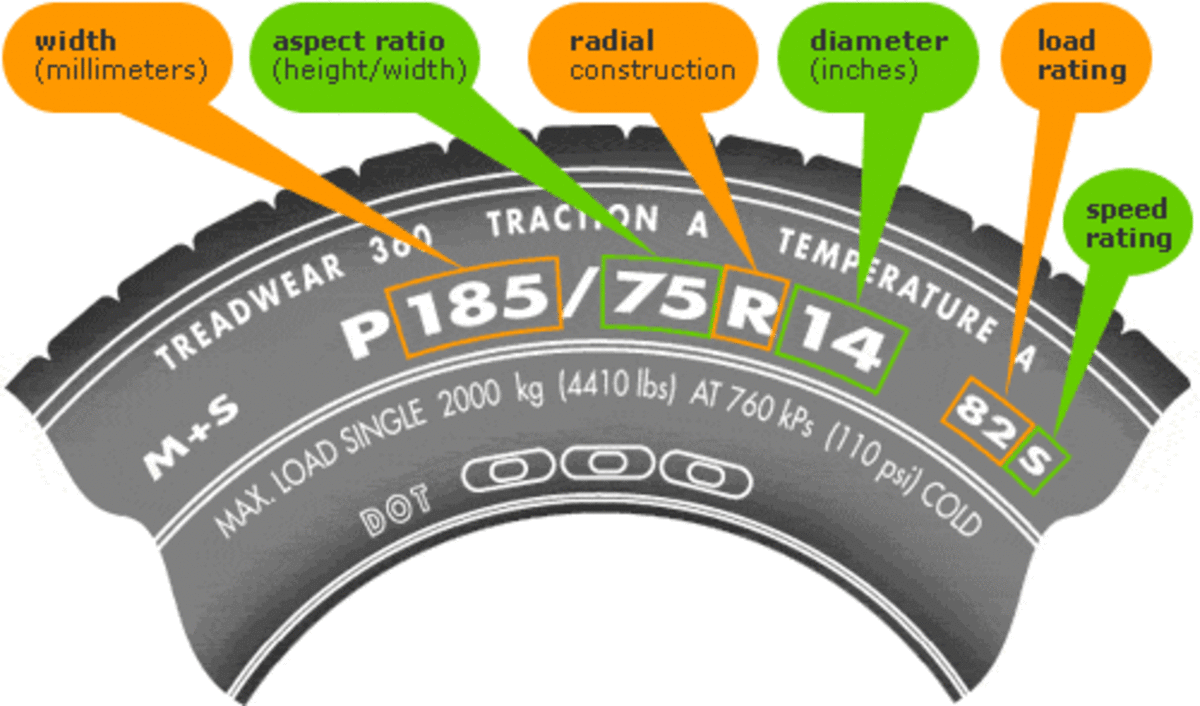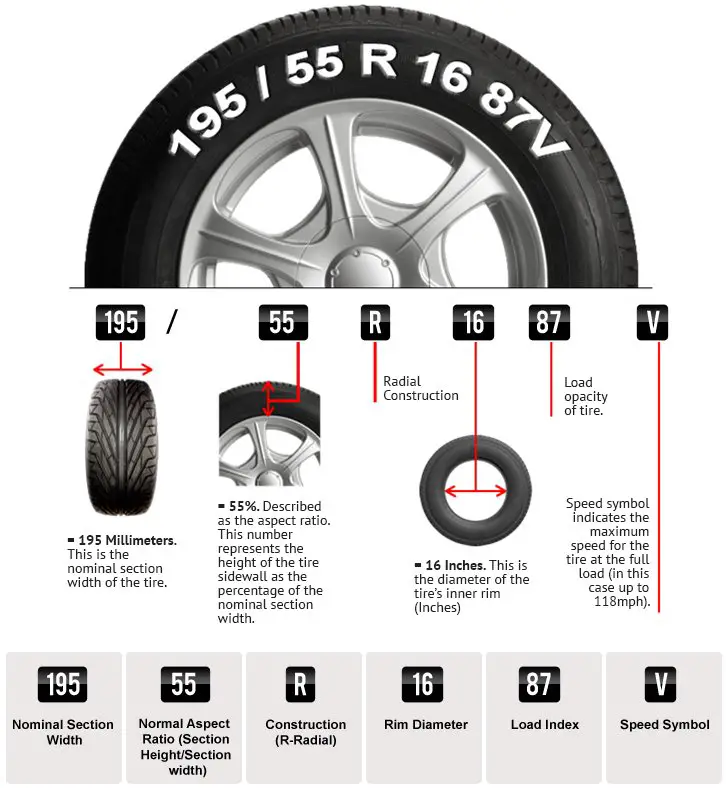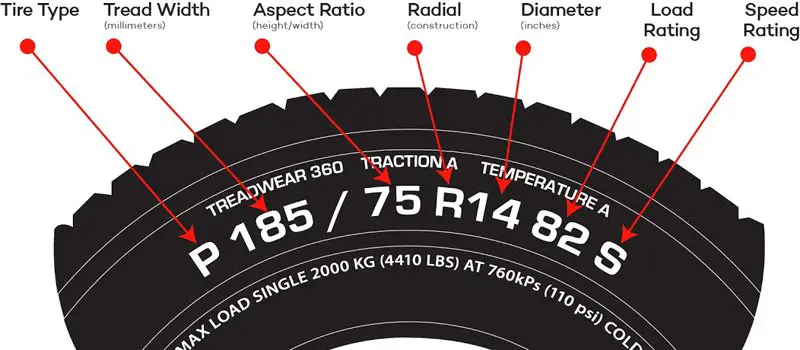What Does The 265 70r17 Mean
This number indicates that your tire has a width of 265 millimeters. 70. This number means that your tire has an aspect ratio of 70%. In other words, your tires sidewall height is 70% of the width. In this case, the sidewall height works out to be 185 millimeters.
Tire And Wheel Diameter
Again using our example tire size from above, the 17 means that the tire should be matched to a 17-inch diameter wheel.
Tires usually come in the following widths : 8, 10, 12, 13, 14, 15, 17, 18, 19, 20, 22, 23, 24, 26, and 28. Tires in these sizes are typically found on most passenger cars, light-duty light trucks, SUVs, minivans, and vans. Tires with a rim diameter measured in inches are called “inch rim” sizes.
What Do The Numbers On Car Tires Mean
The abbreviations used in car manufacturing can seem like gibberish to the uninitiated. Weird numbers like P195/75R14 92S can make consumers throw up their hands in despair and turn over responsibility for choosing new tires to the salesperson at the dealership or to a knowledgeable family member. In reality, these numbers are easy to decipher, once you understand the following key.
The first part of the sequence identifies the type of vehicle the tire is intended for. P is a passenger tire , T is for temporary use , and LT is for light truck.
The first numbers, before the slash, indicate the section width of the tire. This is not the tread width, but the width of the widest point of the tire. This number is in millimeters and the smaller the number is, the shorter or narrower the tire will be.
Immediately following the slash is the aspect ratio. It is the height of the tire expressed as a percentage of the section width. Higher performance tires have a smaller aspect ratio.
The next letter describe the construction or type of the tire. Standard car tires will have an R for radial ply construction.
Next is the rim diameter. Unlike the previous measurements, rims are measured in inches.
You May Like: How Much Does A Car Salesman Make Per Car
What Do Different Numbers And Letters Mean On The Sidewall Of The Tire
The first three numbers indicate the width of the tire tread in millimeters. 60 is the aspect ratio or profile of tire. This is indicated in percentage of the tire width. R stands for the construction method of the tire indicating the tire is a radial tire. The following two numbers indicate the diameter of the wheel rim in inches. The next two or three numbers indicate the load index of the tire. In the example, 94 means the tire can carry 670kg. of weight when the car is doing the maximum speed set for the tire. The last letter is the speed symbol. In the example T indicates that the maximum speed for the tire in 190km/h with maximum weight and ideal air pressure.
Frequently Asked Questions About Tire Age

Do tires get hard with age?
Yes, the rubber gets hard over time as the tire loses its elasticity. This happens regardless of how much you use your tires over the course of the years.
Is there a firm date to replace my tires?
Every tire has a birthday, and many tires will not be sold 7 years later. However, since some tires dont technically become unsafe until a decade after theyre produced, the best advice is to have your tire checked by a professional to make sure they are safe for continued driving.
If you have any questions about your tires DOT Code or tire age in general, get in contact and let us assist you!
You May Like: How To Buff Out Scratches On Your Car
Should I Get H Or T Rated Tires
Tires with higher speed ratings generally have better steering response and cornering grip than lower-speed rated tires, in addition to being capable of higher speeds. So if your car originally came with Hrated tires, thats what you should replace them with. Sticking with Hrated tires comes at a cost.
How To Find Load Index
Next to your tire size you will see a number and letter combination like 94H. The number 94 is the load index. This is the number relative to the weight capacity of the tire. The higher the number, the greater the load carrying capability of the tire. Load index ranges from 0 to 150.
If you are replacing your tires, they have to be the same or higher load index, never lower. For example, if your current load index is 103, a tire of the same size with a load index of 112 would work for you, but not a tire of the same size with a load index of 94. If you replace your tires and the new ones have a lower load index, the tire has a high likelihood of bubbling and eventually blowing out.
Read Also: Car Salesman Pay Plan
How Old Are My Tires Dot Date Code Tells You
Are you concerned about the age of your tires?
This quick guide will help you find the manufacture date of your tire and understand how Tires Easy handles tire age based on the DOT Code. Keeping a record of your tires and understanding their age will help you save money on repairs and take proper care of your vehicle.
Understanding Tire Load Index
Just after the tire size are some more numbers, commonly 100T. The 100 is the tires load index, and in the case of 100, it means by itself a properly inflated tire can hold up 800 kilograms . Four tires can hold 3,200 kilograms, which for many vehicles provides plenty of capacity for holding up the vehicle and anything that might be inside.
With each increase by one, such as 100 to 101, you would increase the load capacity of the tire by 25 kg .
You May Like: What Do Car Detailers Do
What Do The 3 Numbers On A Tire Mean
B: TIRE WIDTH The three-digit number following the letter is the tires width in millimeters. Its the height of the sidewall measured from wheel rim to top of the tread, expressed as a percentage of tire width. In other words, its sidewall height divided by tire width.
Why Tire Size Matters
Other than the fact that tires need to physically fit on your vehicle, there are several reasons why having the correct tire size is necessary.
Your tires support the entire weight of your vehicle and are the only parts of your car that actually make contact with the road. Making sure that you select the proper tire size when its time to shop for new tires is critical to the health of your tires and vehicle.
A tires job is to carry your vehicle and guide it where it needs to go, so when a tire is too large or too small, not only is performance hindered but your safety is also put at risk. Your tires need to be wide, strong and thick enough to carry the weight of your vehicle while still being able to turn and move. Scratching along the sides or getting caught while trying to turn could cause serious damage to your tires, forcing you to replace them much sooner than youd otherwise need.
Recommended Reading: How To Copy Mp3 To Cd To Play In Car
What Do The Numbers On Tires Mean
There’s a massive amount of information branded on the sidewall of every tire … but it’s written in code. The tire size is just one small piece of this code. The tire size “P225/45R17 91V” may not mean much to the average person, but to tire geeks like us it speaks volumes. Read on to learn how to crack the tire code with this handy guide dedicated to tire types, sizes, and construction.
Innovation In Tire Technology

Airless tires have a honeycomb or ribbed cross-section and dont need to be filled with air
Related ArticlesRelated Articles
Recent advancements in tire technology have led to the development of airless tires, which feature a visible cross-section. This cross-section can either be in a honeycomb or ribbed pattern that is flexible to emulate the behavior of air. The benefit of such a tire is that it is puncture-proof!
Airless tires are still in a nascent stage of development, meaning that it will still be a few years before we see them in mainstream production.
Don’t Miss: Freshies For Car
Where To Find Tire Size
No matter what vehicle you drive, finding the manufacturer-recommended tire size should be easy. The best place to start looking is the ownerâs manual.
Donât worry if you canât locate the manual you may also find a tire fit guide in these locations:
The driverâs side door jamb
Inside your glove box door
Within your gas tank hatch
Assuming theyâre the proper size, you can find tire size data on the sidewall of your current tires. However, no matter where you find your tire size, you will have to decipher a sequence of numbers and letters.
How To Read Sidewall Tire Numbers And Markings
The sidewall of your tires is filled with important information that tells you everything you need to know about your tire. The numbers can be a bit overwhelming to the untrained eye, so the best way to understand tire markings is to take an example and break it down, bit by bit.
Below are tips and information to help you learn how to read tire size and other tire markings commonly seen in the U.S.
Recommended Reading: How To Make Car Freshies
Can I Put 2 Different Size Tires On My Car
Long story short: Yes, it is a problem to have two tires of different sizes on the front of your car. Having two differentsized tires on the same axle is generally not a good thing. Sometimes, people choose to put larger tires on the rear axle of their vehicle for handling reasons, cosmetic reasons, etc.
Everything You Need To Know Is On The Sidewall
The sidewall of a car’s tire has important information that tells you almost everything you need to know about it. Our video quickly breaks it down for you:
Here’s a more detailed explanation. In this example, the code is: P215/65R 15 95H:
Service Description The service description may not always appear on the tire, but it is important to know how it can affect your vehicle. If there is a “P” on the sidewall, it stands for “passenger car.” This refers to the U.S. method of tire sizing. “LT” stands for Light Truck, “ST” is for Special Trailer and “T” stands for Temporary, which is primarily used for small spare tires. If a tire does not have a “P” or another letter in front of the numbers, it is considered a “Euro-metric” tire. A Euro-metric tire conforms to the European tire specifications, and often carries a different load index than a comparably sized P-metric tire. We’ll discuss load index in more detail below.
Tire Width The first number in this series refers to the tire’s section width, or the distance from sidewall edge to sidewall edge, measured in millimeters up and over the tire’s tread. Generally speaking, the larger this number is, the wider the tire will be.
Rim Diameter This is the wheel diameter, in inches, for which the tire was sized. Pay particular attention to this number if you plan on upgrading your wheel size. If your wheel diameter changes, you’ll have to purchase a new set of tires that matches this new diameter.
You May Like: Vaseline Interior Car Scratches
Height To Width Ratio:
The third item in the code is the ratio of the tires height to its width. In this example, the height is 45% of the tires width. Mounting tires of a different height ratio can change the way your cars suspension behaves. This is rarely worthwhile in daily drivers, but off-road enthusiasts can find the added ground clearance worth the adjustments.
What Is The Dot Tire Identification Number
Let’s get one thing out in the open right away: The DOT Tire Identification Number isn’t sexy, exciting, or cool. But it can be pretty useful, once you understand what it is.
Under Federal law, tire manufacturers are required to brand standardized information onto the sidewalls of all tires sold in the United States. This includes details about the tire’s basic characteristics, construction, various capacities , as well as the DOT Tire Identification Number. The DOT number is used for safety standard certification and also in the event of a tire recall by the manufacturer.
According to current regulations, the DOT Tire Identification Number must begin with the letters DOT followed by a series of characters . These characters identify the tire size and manufacturers specifications, as well as the manufacturing location and date the tire was manufactured . People often think the DOT number is a product serial number, but it’s actually a way to identify the manufacturers production batches.
You May Like: What Year Is My Club Car Golf Cart
Proper Storage Increases The Life Of The Tire
When stored properly and protected from the elements, tires age quite slowly. The Rubber Manufacturers Association has said theres no way to put a date on when tires actually expire. There are too many factors that impact the true age of a tire.
To help prolong the life of a tire, tire retailers will:
- Protect the tires from UV rays or excessively high temperatures.
- Keep the tires cool and dry to prevent deterioration.
- Eradicate moisture or humidity that could compromise the tires.
- Prevent tires from freezing when temperatures drop.
While these are the main contributors to excessive tire aging, it would still take years of exposure in the hottest, wettest, and driest climates for the first signs of tire aging to appear. Tires are durable, and if theyre showing signs of damage within the first few years, its a sign of poor quality. Whitening of the rubber and shallow hairline cracks in the upper or lower sidewall may be an indication of UV and heat damage, but these symptoms arent issues you commonly see in new tires.
Sidewall cracking due to UV rays
Why Are These Numbers Important

Obviously, tires have to fit on the wheels, so the width is critical, but less obvious is the effect on various systems in your Toyota. If your car is specified to ride on P225/65R17 tires, changing to P225/55R17 which has smaller sidewalls will throw off your speedometer, which was calibrated based on the diameter of the P225/65R17 tires. Its also important to choose tires with similar or higher load and speed ratings to avoid the risk of a blowout due to under-rated tires.
Finally, getting the speed rating right is important because tires are under extreme stress when rotating at high speeds. The combination of centripetal force and centrifugal force is an important consideration for an engineer who is selecting tire speed ratings.
Shopping for new tires can seem to bring about a bewildering array of numbers and ratings and symbols, but understanding the basics and consulting with your certified Toyota technician will help clear up all confusion.
As the only interface between your Toyota and the road, tires are arguably the most critical wear item on any vehicle. Since each tires contact patch on the road is about the size of your hand, getting the right tire for the job is important.
Don’t Miss: Request Car Title Florida
Tire Size Explained: What Do All The Numbers Mean
Tire size specifications are outlined by the numbers and letters found on the sidewall of tires.
It is important that we understand tire geometry and be informed of the parameters that govern their performance. Tire sizes are defined by specifications such as the type, width, aspect ratio, speed rating, tire construction type, and service description.
There are two organizations – Tire and Rim Association and European Tyre and Rim Technical Organisation – that influence tire standards.
Are Wider Tires Better
From a safety point of view, both types have their good sides: On a dry road, wider tires will offer more grip than narrow ones, but the risk of aquaplaning will be higher with wide tires. In the winter, narrow tires are better under extreme conditions as they provide higher surface pressure against the road.
Recommended Reading: How Much Does A Car Salesman Make Per Car
What Do The Numbers And Codes On Gasoline And Tires Mean
Theres a lot of shopping people do in the automotive aftermarket, from tires to what you put in your gas tank. What do the different numbers on some of these products mean? What are octane ratings? What are those codes on the side of tires? Purchasing the wrong number of one of these items may not only be unnecessary it may be harmful to your car or even make driving your car dangerous.
M& s Vs Mountain And Snowflake
M& S, for mud and snow, is a misleading symbol, as it doesnt really indicate a tire suitable for use as a winter tire. The mountain and snowflake symbols guarantee the tire met certain minimum standards for cold-weather traction, performance in snow and on ice.
Most all-season tires come with the M& S symbol, while only true winter tires come with the mountain and snowflake. Winter tires are designed to perform optimally in both snowy conditions and cold temperatures, providing the performance and safety you expect. In fact, theyre recommended as soon as average daily temperatures drop below 7 degrees Celsius. For passenger vehicles, they are legally required on some B.C. highways after Oct. 1 and in Quebec between Dec. 15 and Mar. 15
Read Also: How To Remove Hail Dents From Car
